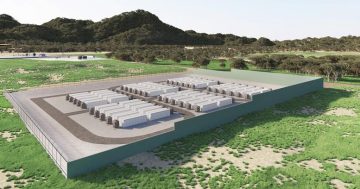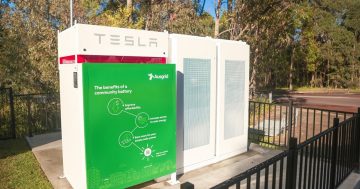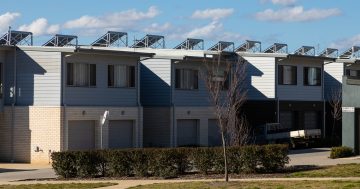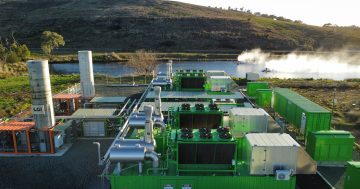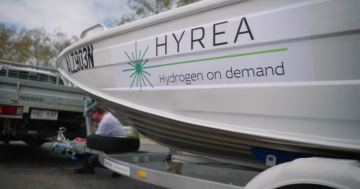
Chief Minister Andrew Barr and Eku’s Daniel Burrows: the new battery facility will store enough energy to power one-third of Canberra for two hours. Photo: Ian Bushnell.
The ACT will take another big step towards securing electricity supply reliability as energy markets decarbonise with a deal to build a $400 million battery energy storage system at Williamsdale adjacent to the sub-station in the south of the Territory.
The 250-megawatt (MW), 500 megawatt-hour (MWh) battery energy storage system will join the Big Canberra Battery project. It will store enough renewable energy to power one-third of Canberra for two hours during peak demand periods, such as heat waves and cold snaps.
The ACT Government will partner with global energy storage business Eku Energy, which will build and operate the facility at its own cost and make its money from buying and selling renewably sourced electricity on the national market, including excess power from the nearby solar farm.
Construction will start in late 2024 with completion expected in 2025.
The government will make fixed quarterly payments to Eku over 15 years, but a key part of the deal is an innovative revenue-sharing arrangement that will deliver a positive financial return to the Territory.
Just how positive that will be, Chief Minister Andrew Barr could not say for commercial-in-confidence reasons, but it will be “consequential”.
“This is not going to solve all of the Territory’s future budget issues, but it will make a positive contribution to the Territory’s bottom line,” he said.
Mr Barr said the ACT was leading the way when it came to renewable energy and this project showed it was also a national leader in battery storage.
He said the deal could be a template for when the ACT added more batteries to the network and for other jurisdictions to deliver positive outcomes across the national energy market.
How many more batteries would be required to fully secure the system depended on local needs such as electric bus and EV charging, but also storage development across the border in NSW and how the national market continued to transition.
“There will come a point, I hope, when the market is nearly saturated with this sort of technology, but we are not at that point yet,” Mr Barr said.
“So the short answer is I expect that there will be further projects, both under the Big Canberra Battery banner and then where you will see current energy, energy suppliers, retailers and others wanting to enter into the space.
“But I think that the national reports are saying we need hundreds more so the ACT will play a role in that, but not 200 in the ACT, but there will be more.”
Mr Barr said the new battery facility would join a growing integrated network that would provide many hours of backup power.
“For example, in a peak summer period, where demand across the east coast was incredibly high, we could inject this extra power into the system, which would mean people wouldn’t experience brownouts on the hottest of days,” he said.
Mr Barr said the deal met the three objectives of the Big Battery project – to grow jobs in the renewable energy sector, create a meaningful revenue stream for the Territory and improve energy security for Canberrans.
At end of life, the government and Eku will be jointly responsible for the site clean-up.
Eku’s head of Asia Pacific and Chief Investment Officer Daniel Burrows said the project would take Eku to its first gigawatt hour of storage in Australia and its global portfolio to 4-gigawatt hours.
“We look forward to delivering safe, secure, reliable energy to the grid and to support Canberrans as they transition to a clean-energy future,” he said.
Mr Burrows said the deal also included commitments to the local community, which would be made known in coming months, and working on renewable energy research with the ANU.
Established last year by Macquarie’s Green Investment Group, Eku Energy says that it combines technical, digital and financial innovation with a local partnership approach and data-driven understanding of markets to develop sophisticated revenue contracting strategies that maximise the benefits of energy storage systems in any given location.
It will support the government’s commitment to achieving net zero emissions in the Territory by 2045.












